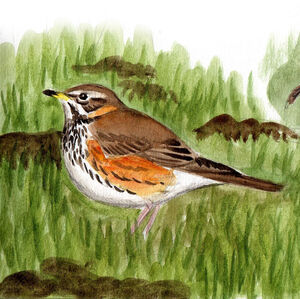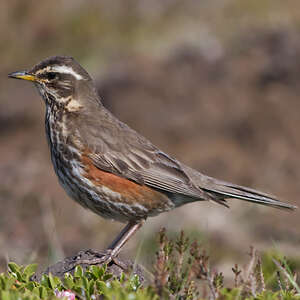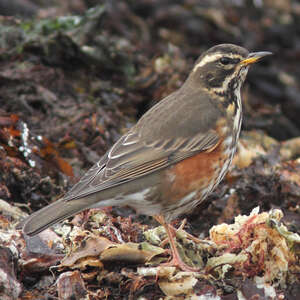Redwing
Turdus iliacus - Grive mauvis
Identification
The Redwing has the size and shape of a Song Thrush but easily distinguishes itself by its plumage. Note the head pattern which is very distinct, likely the most distinct among all thrushes. The most eye-catching feature is the sharp cream and white supercilium that runs from the beak to the neck, tucked between the crown and the cold dark brown ear-coverts. Another conspicuous white feature is the sub-mustacal stripe that slots between the brown cheeks and the darkish moustachial line that edges the white striated black throat and ends in a black patch at the base of the neck. The dark eye is blended in with the black lores and under the eye a small pale patch can be detected. The bill is black with yellow at the base of the lower mandible. The underparts are white although the flanks are a vivid rusty orange that captures the eye and designates the species. The ventral spots are pointy arrowheads that arrange themselves in typical longitudinal formations. Towards the bend of the wings, dark patches are often present, somewhat like the Spotted Flycatcher's. The juvenile can be recognised by its mantle, scapulars and tertials that are streaked/spotted beige or fawn. The first winter bird is distinguished from the adult by its large coverts and white-tipped tertials
Subspecific information 2 subspecies
- Turdus iliacus iliacus (n and e Europe to c Siberia)
- Turdus iliacus coburni (Iceland and Faroe Is.)
Foreign names
- Grive mauvis,
- Zorzal alirrojo,
- tordo-ruivo,
- Rotdrossel,
- szőlőrigó,
- Koperwiek,
- Tordo sassello,
- rödvingetrast,
- Rødvingetrost,
- drozd červenkavý,
- drozd cvrčala,
- Vindrossel,
- punakylkirastas,
- tord ala-roig,
- Skógarþröstur,
- droździk,
- plukšķis,
- vinski drozg,
- Белобровик,
- ワキアカツグミ,
- 白眉歌鸫,
- rödvingetrast,
- 白眉歌鶇,
Voice song and call
The contact call is a prolonged, fine, incisive but slightly fuzzy whistle. It can often be heard on October nights, even in the city. The Redwing also makes a nasal gak. The alarm call is a series of harsh and sharp trèt-trèt-trèt-trèt..... The song, which varies depending on the individual, is recognizable by its sound and structure. It consists of relatively short verses separated by long pauses of 3-6 seconds. Each verse consists of a sound truui truui truui, followed by a soft, squeaky twitter. During pre-nuptial migratory stops, the males sing in chorus and make a concert that does not go unnoticed.
Habitat
The true home of the Redwing is the northern part of the continent. It is typically a bird of the taiga and the tundra.
In migration, it can be seen everywhere. It makes a stop in the forest. In winter, it frequents the different woodlands available, spaces bordered by hedges and more open habitats such as agricultural areas, especially meadows and pastures. In North Africa, it can be found in orchards and forests. When the climatic conditions are rigorous, the Redwing penetrates urban gardens.
Behaviour character trait
Redwings are migratory birds. Almost the entire population winters in Europe, from the British Isles to Turkey.
Departure usually takes place in flocks. Even in large cities, it is possible to observe the migration of the Northern Redwing. Just go out during the night, listen, and soon you will hear the call siii with which birds communicate in flight and maintain contact. When they are on the ground, Redwings have habits similar to those of the Song Thrush, although they tend to be more gregarious, especially in winter when they form large flocks with Fieldfares and Blackbirds that can group more than 200 individuals. In North Africa, they associate more with Blackbirds. All these species perch together in woods, shrubs, thickets and hedges. When disturbed while in an open area, they quickly fly towards the closest trees, then return to the areas where they were previously as soon as the danger has passed.Dietfeeding habits
This Redwing has a varied diet, both insectivorous and frugivorous. Among the invertebrates, it searches for ants, beetles, crickets, grasshoppers, flies, spiders, centipedes, small snails, slugs and earthworms on the ground.
The list of fruiting plants is also abundant: brambles, sloes, gooseberries, bilberries, elderberries, hawthorns, ivies, juniper, madder, pears, olives, wild strawberries, yews, etc. The small fruits are taken either still on the plant or fallen on the ground.
Reproduction nesting
Redwings build their nest on the ground or low to the ground in trees. Both the male and female participate in building the nest, but the female tends to incubate the eggs alone.
The clutch size is usually 4 to 6 eggs, similar to those of a blackbird. The nest is very well constructed with grass, leaves and fine roots, and reinforced with a layer of mud to keep it secure to the branch. After 14 days, the little ones break their shell with their beaks. They gain size very quickly and after two weeks they jump out of the nest. Nevertheless, the parents keep caring for them for a while. During breeding season there are usually two clutches, except in Northern regions and mountainous regions of the Scandinavian Alps.Geographic range
The Redwing breeds in a vast boreal zone stretching from the North Atlantic islands to Eastern Siberia. The coburni subspecies nests in southeastern Greenland (very locally), Iceland, and the Faroe Islands. The nominate subspecies iliacus nests in Scotland, Fenno-Scandia, the Baltic states, and throughout Siberia.
It is a total migrant and will spend the winter in western Europe, around the Mediterranean and Black Seas, in the Caucasus region, and south of the Caspian Sea.
Threats - protection
Sources of information
- IOC World Bird List (v15.1), Gill, F and D Donsker (Eds). 2025-12-07.
- Vol. 10 - Handbook of the Birds of the World, Josep del Hoyo-Andrew Elliott-David Christie
- Les passereaux d'Europe, tome 2, P. Géroudet, M. Cuisin
- Thrushes, Peter Clement and Ren Hathway
- Animal Diversity Web, University of Michigan Museum of Zoology
- Avibase, Lepage Denis
- Birds of the World, The Cornell Lab of Ornithology
- xeno-canto, Sharing bird sounds from around the world,
Other sources of interest
 Specification sheet created on
28/10/2023 by Alexandre Knochel with help of Daniel Le-Dantec
Specification sheet created on
28/10/2023 by Alexandre Knochel with help of Daniel Le-Dantec partially rewritten on 00/00/0000 by Jean François
Translation by AI Oiseaux.net
© 1996-2026 Oiseaux.net
- Accipitriformes
- Aegotheliformes
- Anseriformes
- Apodiformes
- Apterygiformes
- Bucerotiformes
- Caprimulgiformes
- Cariamiformes
- Casuariiformes
- Charadriiformes
- Ciconiiformes
- Coliiformes
- Columbiformes
- Coraciiformes
- Cuculiformes
- Eurypygiformes
- Falconiformes
- Galliformes
- Gaviiformes
- Gruiformes
- Leptosomiformes
- Mesitornithiformes
- Musophagiformes
- Nyctibiiformes
- Opisthocomiformes
- Otidiformes
- Passeriformes
- Pelecaniformes
- Phaethontiformes
- Phoenicopteriformes
- Piciformes
- Podargiformes
- Podicipediformes
- Procellariiformes
- Psittaciformes
- Pterocliformes
- Rheiformes
- Sphenisciformes
- Steatornithiformes
- Strigiformes
- Struthioniformes
- Suliformes
- Tinamiformes
- Trogoniformes

































